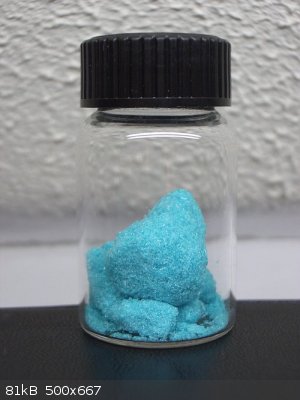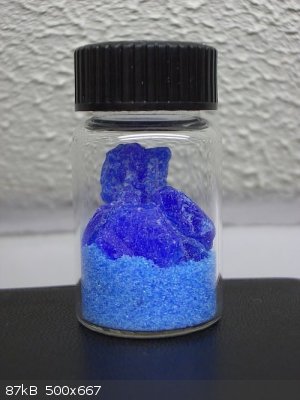Chemguy5
Harmless

Posts: 27
Registered: 11-7-2018
Member Is Offline
|
|
CuCl2.2H2O synthesis help
I need to make some CuCl2.2H2O and I was wondering if all I had to is add copper metal to HCL and add in some H2O2 then evaporate off the water to
leave CuCl2. But wouldn't this leave me with anhydrous CuCl2? How do I make the dihydrate?
|
|
|
DraconicAcid
International Hazard
    
Posts: 4333
Registered: 1-2-2013
Location: The tiniest college campus ever....
Member Is Online
Mood: Semi-victorious.
|
|
If you just let the water evaporate, you will get the dihydrate. You have to heat the dihydrate to get the anhydrous material.
Please remember: "Filtrate" is not a verb.
Write up your lab reports the way your instructor wants them, not the way your ex-instructor wants them.
|
|
|
Chemguy5
Harmless

Posts: 27
Registered: 11-7-2018
Member Is Offline
|
|
Duuhhh! I should have known that ! Sorry silly question didn't really think it through
|
|
|
DraconicAcid
International Hazard
    
Posts: 4333
Registered: 1-2-2013
Location: The tiniest college campus ever....
Member Is Online
Mood: Semi-victorious.
|
|
The only silly question is the one that isn't asked until it's too late.
Or at least, that's what my skydiving instructor used to say.
Please remember: "Filtrate" is not a verb.
Write up your lab reports the way your instructor wants them, not the way your ex-instructor wants them.
|
|
|
MrHomeScientist
International Hazard
    
Posts: 1806
Registered: 24-10-2010
Location: Flerovium
Member Is Offline
Mood: No Mood
|
|
You could also start with malachite and dissolve that in HCl. Evaporating the water yields the green/blue dehydrate and further strong(ish) heating
gives the brown anhydrous compound. Copper chloride is neat because it is blue when dilute, but if you increase the chloride concentration (by
evaporation or adding another chloride like NaCl) it turns green. Copper chemistry is beautiful.
|
|
|
Swinfi2
Hazard to Others
  
Posts: 131
Registered: 19-2-2018
Location: England
Member Is Offline
Mood: Catalytic
|
|
Quote: Originally posted by MrHomeScientist  | | Copper chloride is neat because it is blue when dilute, but if you increase the chloride concentration (by evaporation or adding another chloride like
NaCl) it turns green. Copper chemistry is beautiful. |
I've been wondering for a two weeks now why my CuCl2 was the wrong colour *facepalm*.
I just used some fine copper wire and ~20%HCl took about a month though. I don't want to be on the governments peroxide list here in the UK. 
|
|
|
DraconicAcid
International Hazard
    
Posts: 4333
Registered: 1-2-2013
Location: The tiniest college campus ever....
Member Is Online
Mood: Semi-victorious.
|
|
Quote: Originally posted by MrHomeScientist  | | You could also start with malachite and dissolve that in HCl. Evaporating the water yields the green/blue dehydrate and further strong(ish) heating
gives the brown anhydrous compound. |
And if you don't have malachite, any soluble copper compound can be treated with sodium carbonate or sodium hydrogen carbonate to give basic copper
carbonate. This will also react with hydrochloric acid to give the desired compound.
Please remember: "Filtrate" is not a verb.
Write up your lab reports the way your instructor wants them, not the way your ex-instructor wants them.
|
|
|
Foeskes
Hazard to Others
  
Posts: 156
Registered: 25-2-2017
Member Is Offline
Mood: No Mood
|
|
I wonder if there was a way to make the solid copper chloride blue.
|
|
|
DraconicAcid
International Hazard
    
Posts: 4333
Registered: 1-2-2013
Location: The tiniest college campus ever....
Member Is Online
Mood: Semi-victorious.
|
|
Only if you got rid of the chloride and replaced it with something else....so, no.
Please remember: "Filtrate" is not a verb.
Write up your lab reports the way your instructor wants them, not the way your ex-instructor wants them.
|
|
|
Foeskes
Hazard to Others
  
Posts: 156
Registered: 25-2-2017
Member Is Offline
Mood: No Mood
|
|
Wikipedia seems to suggest that the dihydrate has a blue-green color.
Isn't it green due to the [CuCl4]-2 complex from excess chloride?
|
|
|
woelen
Super Administrator
        
Posts: 8013
Registered: 20-8-2005
Location: Netherlands
Member Is Offline
Mood: interested
|
|
Pure copper(II) chloride dihydrate is bright cyan, the anhydrous salt is brown. The cyan color is quite different from the blue of hydrated copper
sulfate or copper nitrate.


|
|
|
Foeskes
Hazard to Others
  
Posts: 156
Registered: 25-2-2017
Member Is Offline
Mood: No Mood
|
|
Quote: Originally posted by woelen  | Pure copper(II) chloride dihydrate is bright cyan, the anhydrous salt is brown. The cyan color is quite different from the blue of hydrated copper
sulfate or copper nitrate.
|
So how did you make it?
Even my local store sells green CuCl2.
|
|
|
DraconicAcid
International Hazard
    
Posts: 4333
Registered: 1-2-2013
Location: The tiniest college campus ever....
Member Is Online
Mood: Semi-victorious.
|
|
Quote: Originally posted by Foeskes  |
Wikipedia seems to suggest that the dihydrate has a blue-green color.
Isn't it green due to the [CuCl4]-2 complex from excess chloride? |
No, it's far more likely to be tetrahedral [CuCl2(H2O)2]. The tetrachloro complex is yellow.
Please remember: "Filtrate" is not a verb.
Write up your lab reports the way your instructor wants them, not the way your ex-instructor wants them.
|
|
|
walruslover69
Hazard to Others
  
Posts: 233
Registered: 21-12-2017
Member Is Offline
Mood: No Mood
|
|
Assuming your original source of chlorine is HCl, you could probably get rid of it by boiling it down, adding more water and boiling it down again as
many times as needed to drive it off.
|
|
|
walruslover69
Hazard to Others
  
Posts: 233
Registered: 21-12-2017
Member Is Offline
Mood: No Mood
|
|
alternatively, you could probably just rehydrate anhydrous cucl2 to have prepare a sample without CuCl4- contaminants
|
|
|
symboom
International Hazard
    
Posts: 1143
Registered: 11-11-2010
Location: Wrongplanet
Member Is Offline
Mood: Doing science while it is still legal since 2010
|
|
How about from copper oxychloride
Bleach and copper sulfate forms copper oxychloride add a little hydrochloric acid converting the oxychloride to copper chloride
|
|
|
AJKOER
Radically Dubious
    
Posts: 3026
Registered: 7-5-2011
Member Is Offline
Mood: No Mood
|
|
Quote: Originally posted by Chemguy5  | | I need to make some CuCl2.2H2O and I was wondering if all I had to is add copper metal to HCL and add in some H2O2 then evaporate off the water to
leave CuCl2. But wouldn't this leave me with anhydrous CuCl2? How do I make the dihydrate? |
The process suggested may also produce a basic copper chloride. Some expected reaction, starting with the presence of copper metal and any created
cupric:
Cu(ll)L + Cu = 2 Cu(l)L
The L (for ligand) relating to the formation of a soluble Cu(l) chloride.
Next two possible sources of H+, namely excess HCl, or from an equilibrium reaction between water and the aqua cupric complex:
[Cu(H2O)6]2+ (aq) + H2O (l) = [Cu(H2O)5(OH)]+ (aq) + H3O+ (aq)
Lastly, an electrochemical reaction, consuming the H+ created in the presence of oxygen (from heating in air) or added H2O2:
O2 (or H2O2) + 4 Cu(l) + 2 H+ → 4 Cu(ll) + 2 OH-
which leads to the basic salt.
Possible solution, periodic addition of fine copper powder well dispersed over hot HCl/H2O2. The goal being to limit the creation of cuprous by
reducing available copper.
An alternate path, use excess copper and limit chloride presence to reduce the creation of a soluble Cu(l) chloride complex.
Nevertheless, I suspect, it is probably hard to avoid forming some basic salt.
Here is an interesting commentary (possibly dated) found on Atomistry discussing cuprous chloride at http://copper.atomistry.com/cuprous_chloride.html .
[Edited on 15-8-2018 by AJKOER]
|
|
|